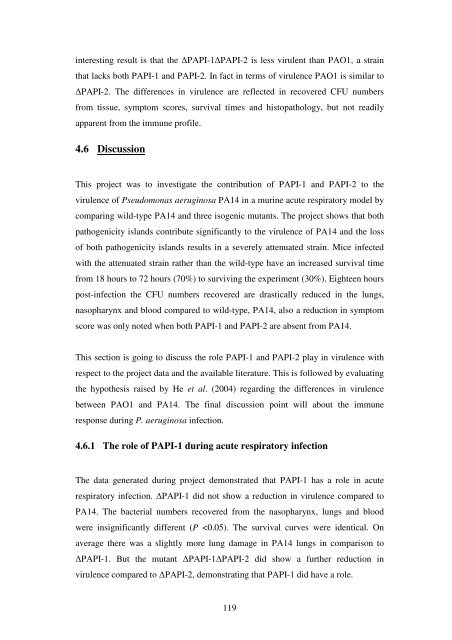5 The role of quorum-sensing in the virulence of Pseudomonas ...
5 The role of quorum-sensing in the virulence of Pseudomonas ...
5 The role of quorum-sensing in the virulence of Pseudomonas ...
You also want an ePaper? Increase the reach of your titles
YUMPU automatically turns print PDFs into web optimized ePapers that Google loves.
<strong>in</strong>terest<strong>in</strong>g result is that <strong>the</strong> ∆PAPI-1∆PAPI-2 is less virulent than PAO1, a stra<strong>in</strong><br />
that lacks both PAPI-1 and PAPI-2. In fact <strong>in</strong> terms <strong>of</strong> <strong>virulence</strong> PAO1 is similar to<br />
∆PAPI-2. <strong>The</strong> differences <strong>in</strong> <strong>virulence</strong> are reflected <strong>in</strong> recovered CFU numbers<br />
from tissue, symptom scores, survival times and histopathology, but not readily<br />
apparent from <strong>the</strong> immune pr<strong>of</strong>ile.<br />
4.6 Discussion<br />
This project was to <strong>in</strong>vestigate <strong>the</strong> contribution <strong>of</strong> PAPI-1 and PAPI-2 to <strong>the</strong><br />
<strong>virulence</strong> <strong>of</strong> <strong>Pseudomonas</strong> aerug<strong>in</strong>osa PA14 <strong>in</strong> a mur<strong>in</strong>e acute respiratory model by<br />
compar<strong>in</strong>g wild-type PA14 and three isogenic mutants. <strong>The</strong> project shows that both<br />
pathogenicity islands contribute significantly to <strong>the</strong> <strong>virulence</strong> <strong>of</strong> PA14 and <strong>the</strong> loss<br />
<strong>of</strong> both pathogenicity islands results <strong>in</strong> a severely attenuated stra<strong>in</strong>. Mice <strong>in</strong>fected<br />
with <strong>the</strong> attenuated stra<strong>in</strong> ra<strong>the</strong>r than <strong>the</strong> wild-type have an <strong>in</strong>creased survival time<br />
from 18 hours to 72 hours (70%) to surviv<strong>in</strong>g <strong>the</strong> experiment (30%). Eighteen hours<br />
post-<strong>in</strong>fection <strong>the</strong> CFU numbers recovered are drastically reduced <strong>in</strong> <strong>the</strong> lungs,<br />
nasopharynx and blood compared to wild-type, PA14, also a reduction <strong>in</strong> symptom<br />
score was only noted when both PAPI-1 and PAPI-2 are absent from PA14.<br />
This section is go<strong>in</strong>g to discuss <strong>the</strong> <strong>role</strong> PAPI-1 and PAPI-2 play <strong>in</strong> <strong>virulence</strong> with<br />
respect to <strong>the</strong> project data and <strong>the</strong> available literature. This is followed by evaluat<strong>in</strong>g<br />
<strong>the</strong> hypo<strong>the</strong>sis raised by He et al. (2004) regard<strong>in</strong>g <strong>the</strong> differences <strong>in</strong> <strong>virulence</strong><br />
between PAO1 and PA14. <strong>The</strong> f<strong>in</strong>al discussion po<strong>in</strong>t will about <strong>the</strong> immune<br />
response dur<strong>in</strong>g P. aerug<strong>in</strong>osa <strong>in</strong>fection.<br />
4.6.1 <strong>The</strong> <strong>role</strong> <strong>of</strong> PAPI-1 dur<strong>in</strong>g acute respiratory <strong>in</strong>fection<br />
<strong>The</strong> data generated dur<strong>in</strong>g project demonstrated that PAPI-1 has a <strong>role</strong> <strong>in</strong> acute<br />
respiratory <strong>in</strong>fection. ∆PAPI-1 did not show a reduction <strong>in</strong> <strong>virulence</strong> compared to<br />
PA14. <strong>The</strong> bacterial numbers recovered from <strong>the</strong> nasopharynx, lungs and blood<br />
were <strong>in</strong>significantly different (P














